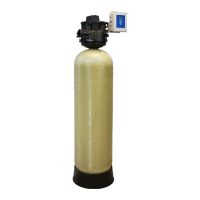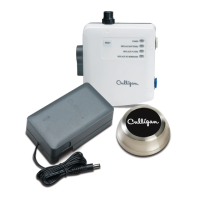48 Culligan® Culligan Top Mount (CTM) Water Softeners
48 Cat. No. 01029401
Sanitize the System
A water softener in daily use on a potable water supply generally requires no special attention other than keeping the salt
tank filled. Occasionally, however, a unit may require sanitization under one of the following conditions:
• At start-up time.
• After standing idle for a week or more.
• On private supplies, the appearance of off-tastes and odors, particularly if musty or “rotten egg” (caused by harm-
less sulfate-reducing bacteria).
NOTE If the water supply contains iron, regenerate the softener before sanitizing to remove iron from the
resin.
CAUTION! Hazard from toxic fumes! Chlorine bleach and common iron control chemicals may
generate toxic fumes when mixed.
If the unit uses Culligan® Sofner-gard® or other compounds containing sodium
hydrosulfate, sodium bisulfate, or any other reducing agent, disconnect the device
feeding the chemical(s) and manually regenerate the unit before sanitizing.
Do not use this procedure if the softener salt contains iron control additives.
1. Remove the brine tank cover.
2. Pour directly into the brine chamber 2/3 of cup to one-cup of common household bleach (5.25% sodium hypo-
chlorite) for each cubic foot of resin in the tank.
3. Manually start a regeneration following the instructions provided in the GBE Programming for Commercial
Softeners and Filters (except for HFxN) Manual (P/N 01027295). This manual can be obtained from your local
dealer, Cport (www.cport.culligan.com) under the Technical Service Tab or the Service Tech App.
NOTE If tastes and odors return frequently, even after sanitization, a continuous chlorination system may be
needed. Send a water sample to a qualified laboratory for bacterial analysis.
Before Leaving the Installation Site
Once you have completed the installation the system is ready to be placed in service. Prior to placing the system in ser-
vice review the following checklist to be sure the system is properly installed.
Check List
√ The media tank(s) has been properly loaded with gravel and media.
√ The drain line has been properly installed.
√ All option kits have been properly installed.
√ The system has been properly piped and tubed.
√ Each media tank has been backwashed manually.
√ The GBE controller(s) have been correctly and completely wired, including differential pressure switches if equipped.
√ All GBE controllers have been properly programmed and are active (power on).
√ All manual isolation valves are open and system by-pass valves are closed.
√ Clean up the unit and the installation site, removing any soldering or pipe threading residues from the equipment with
a damp towel.
√ Explain the operation of the system to the customer.
√ Advise the customer to check and replenish the salt supply regularly.
Care and Cleaning
Protect the operation and appearance of the water conditioner by following these precautions:
1. Do not place heavy objects on top of the conditioner cover.
2. Use only mild soap and warm water to clean the exterior of the unit. Never use harsh abrasive cleaners or com-
pounds which contain acid or bleach. Culligan recommends Simple Green or an equivalent cleaner.
3. Protect the conditioner and drain line from freezing temperatures.

